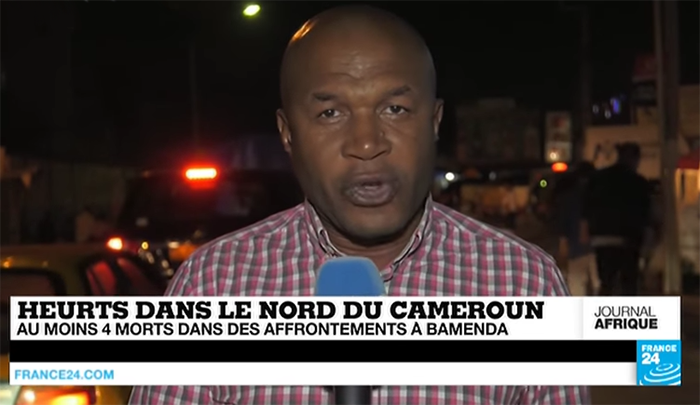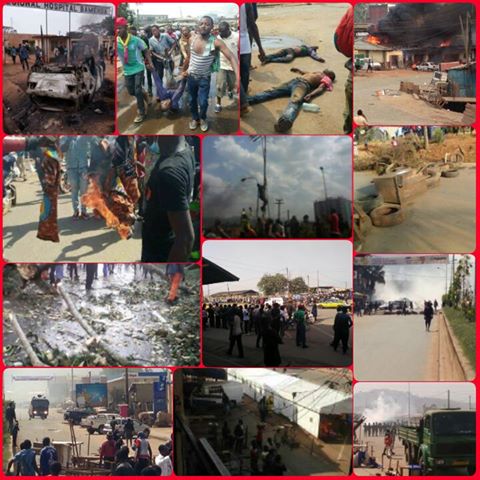
BAMENDA. Clashes have occured between the Government and population in the South West (Buea) and North West (Bamenda), the two English regions of the country. People are demanding a federation or independence. The clashes started with a strike action carried out by teachers and lawyers in regions in order to improve the work conditions for the profession since french part of the system is occupying all the positions.
By Lilian Neg, Africa-Cameroon correspondent | Contact Lillian: Facebook.com for book and lecture inquiries
Unfortunately the strike actions turned into a battle field between police forces and the angered population who came out in numbers to fight for their rights.
This problem started in the earliy 1960:th when Eastern Cameroon under French trusteeship got independence while Southern Cameroon was still under the British trusteeship but later got independence on the 1st of October 1961. Being a small territory, a referendum was organized to permit Southern Cameroon either to join the Federal Republic of Nigeria or to become part of Cameroon, not standing the fact that it could have been a another decision for Southern Cameroon to be considered as a proper State. Nevertheless at that time only the first option was possible.
Southern Cameroon
Therefore, Southern Cameroon decided to join the Republic of Cameroon to conserve their autonomy, because being part of Nigeria would simply mean assimilation, and no an identity of Southern Cameroon.
From 1961 to 1972, the two territories decided to form a federal government (Federal Republic of Cameroon), with two capitals retained: Buea and Yaounde. The flag was colored green, red, yellow with two stars included on the green band. This federal system was smooth when unilaterally, the 1st president Amadou Ahidjo from Eastern Cameroon decided in 1972 to create a new State called United Republic of Cameroon without acknowledging the other part (Southern Cameroon).
As a dictator, he decided to change the whole political system, the federal system, he transformed all the agreements made and the flag (green, red, yellow with a star at the red band). He governed until 1982 when he resigned.
Paul Biya the current president since 1982
Then, the second president Paul Biya from Eastern Cameroon came into power, and continued the policy implemented by the predecessor. He went further by creating in 1984 by decree, the Republic of Cameroon.
Biya adopted a new constitution which stipulates “Cameroon is one and indivisible nation”. A position which was far from the consortium made in 1961 between the Southern Cameroon and Eastern Cameroon. He decided to assimilate the former Southern Cameroon, the system, the citizen and the institutions.
As a matter of fact, legal figures, dignities of Southern Cameroon, Diaspora uncomfortable with the situation clarified the problem at the General Assembly of the United Nation, the United Nations Security Council and the International community. The problem is still pending until a solution is given.
It should be noted that during the process of assimilation, basic rights of citizen of Southern Cameroon were violated, Southern Cameroonian have frequently been marginalized. Joseph Wirba a Southern Cameroonian parliamentarian described this during a plenary session at the parliament as a shame for humanity. The culture inherited is practically disappearing.

A struggle for restoration
The recent fight for freedom engaged by lawyers and teachers of Southern Cameroon brings back the problem to the front. Lawyers decided to go on strike action because they are demanding the recognition of the common law which was practiced in Southern Cameroon; they said the judicial system in the French part of the country is not similar to the one used in Southern Cameroon.
Teachers on their own part decided to close the schools earlier to carry out their voices. For more than a month they were protesting. They said the French system of education is taking over the English system; more over French teachers who are brought in the English system of education are not qualified to the task and if nothing is done the English system will disappear.
The anger of Southern Cameroonians led to a radical movement called: The Southern Cameroon National Council (SCNC) which was created a few years after the reunification to defend Southern Cameroonian rights with the clear option of Independence.
This movement says the government of Cameroon has totally failed, the government of Cameroon has totally run over the people of Southern Cameroon for more than half a century. People have been living in precariousness, no roads, no development projects, no important position at the government whereas Southern Cameroon is rich with diversities and natural resources, nothing to carry from the union.

This state of mind is taking proportions due to the rate of violence that has occurred in Southern Cameroon (North West and South West region).
In December 08th 2016, the population in Bamenda came out in numbers to refuse the organization of a political rally in support of the government actions. This rally was organized at a time when population were furious because of the increasingly nature of discrimination and marginalization.
A few days ago, policemen brutalized students on strike at the English University of Buea while lawyers and teachers were severely beaten, draged on the floor with their robes as they were carrying out their protests against the mismanagement of the English judicial and educational system. This rendered many casualties and arrests. Human rights are violated. Rapes are frequent in this part of the country. Due to these incidents, Southern Cameroon is heavily militarized and the aim is to intimidate the population.
Solution
The government needs to call for a possible round table or referendum to discuss the relevant preoccupation of Southern Cameroonians. The government needs to bring together the former two parties to an agreement on how the future Cameroon should be governed: therefore three options are clearly indicated:
- Federalism as it was viewed in 1961 between the two territories;
- Independence meaning total separation, or
- finally the less appreciated unity in decentralization which means, the two parties will decide to maintain the union while reinforcing the governance at the local level.
One thing is certain; in order to survive challenges, Cameroonians need and must take a decision which will lead the future generation to a better management.
By Lilian Neg, African correspondent for NewsVoice
Relaterat
CIA – The World Fact Book: Cameroon


